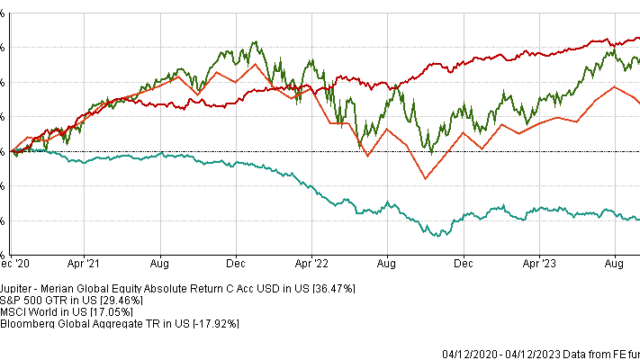Global macroeconomic and geopolitical conditions in 2022 resulted in most asset classes and regions correlating on a downward trend. “Investors had nowhere to hide,” Amadeo Alentorn, head of systematic equities, Jupiter Asset Management, told FSA.
Diversification through traditional asset classes was inadequate, and indeed, 2022 ranked the third worst year for traditional 60/40 portfolios (S&P 500/ US 10-year Treasury) since 1928.
However, the $1.9bn Jupiter Merian Global Equity Absolute Return fund, which London-based Alentorn co-manages, has been able to provide uncorrelated returns, while reducing portfolio risk, through a market neutral approach.
It takes long and short positions in stocks (although they are not paired) to maintain that neutral position, with an average holding period of three to six months for each individual position.
During the 14 years since the fund’s inception, 69.8% of its returns are attributed to long positions and 35.1% to its short positions.
The fund has a three-year cumulative return of 36.47%, outperforming the S&P 500 (29.46%), the MSCI World (17.05%) and the Bloomberg Global Aggregate (-17.92%), according to FE Fundinfo data.
Nevertheless, Alentorn pointed out that interest rates have had a highly positive effect on the strategy’s total return during the past year, making up 4.6 percentage points out of a total return of 10.3%, net of fees, trading costs and borrowing costs for short positions, between 30 September 2022 and 30 September 2023.
It has generated alpha of 11 during the same period, with annualised volatility of 4.6%, compared with 17.01% by the S&P 500, 16.26% by the MSCI World and 6.65% by the Bloomberg Global Aggregate, FE Fundinfo data shows.
The fund charges a 75 basis points management fee and 20% on returns above the cash rate.
Alentorn is keen to advocate the merits of this strategy to wealth mangers and family offices in Hong Kong and Singapore.
“The key characteristics of a market neutral strategy include a low correlation to both bonds and equities, a globally diversified equity portfolio that generates returns from alpha rather than beta,” he said. “It also experiences bond-type volatility of no more than 6%, and offers investors daily liquidity from a Ucits structure,” he said.
The fund aims to deliver an absolute return irrespective of market conditions over rolling 12-month periods, and a return, net of fees, in excess of the Federal Reserve Funds Target Rate over rolling three-year periods.
To do this, a universe of 7,000 large-cap stocks is analysed to construct a long-short portfolio of diversified alpha sources.
There are five elements incorporated in the analysis: attractive valuations with a quality component to reduce downside risk; sustainable growth at a reasonable price; company management, including its signalling of dividends and buybacks; sentiment expressed by fund flows and sell-side analysts’ recommendations; and perhaps most of all, market price trends – that is momentum, as long as it is supported by fundamentals.
Alentorn “tilts weightings among these factors after assessing the market environment’s sentiment and risk”. Currently, the portfolio is most weighted to “sentiment” and “market dynamics”.
“Diversified sources of returns help to achieve a balanced outcome during market uncertainty,” said Alentorn.
Jupiter Merian Global Equity Absolute Return fund vs major indices


















